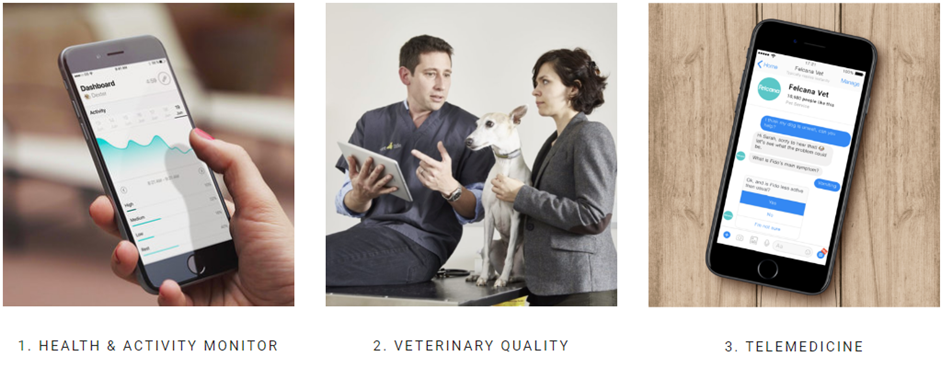The humanization of pets has opened a new world of digital pet healthcare
Is your pup part of the family? Does your cat rule the roost? The humanization of pets has opened up a new world of premium products. In late June, Foresight Factory hosted The Creative Exchange, a program which invites innovators, experts and industry disruptors to share their ideas. We invited James Andrews, the founder of digital pet healthcare startup Felcana to tell us more about owners and how the pet healthcare market is a precursor for human health trends.
Felcana runs a 360 health monitoring system. It combines information from wearable devices, historic vet data and common patterns for the breed and age of a pet. This is used for early identification and treatment of illnesses. Felcana collects data in real time through a specialist collar chip and Bluetooth beacons that track visits to water and food bowls. According to Felcana, its system has three main benefits. First, the device allows for remote monitoring of pets from home. Second, analysis of the data provides early warnings of illness to both the owner and the vet. Third, a telemedicine feature makes Felcana a one stop center for health advice, enabling a teleconsultation at the tap of a button.

From Andrews’ insight on the trends shaping the pet industry, we identified 5 key actions for brands:
Appeal to the pet parent
A large number of consumers see their pets as a member of the family. The Charity Awareness Monitor finds that 86% of UK consumers agree that they see their pet as “part of the family”. Those who identify as pet parents are likely to spend more, as being part of the family calls for high quality care. Here, the trends we see in the human sector can be applied with confidence to pet products. As a result, products using terms such as vegan, organic, gluten-free, locally produced will appeal to consumers who want their pet’s brand to align with their own values.
In addition, digital solutions such as Felcana reassure pet parents. A dog cannot communicate that its walker did not go far enough today and a cat can not say that it feels unwell. Thus, Felcana monitoring gives consumers complete control and alerts owners when behavior changes. It provides pet parents with peace of mind.
Remember that pet ownership is performative
The cycle of popular breeds and the 185m post on Instagram with #dog show that ownership is also performative. According to Andrews, premium pet products have the biggest opportunity for expansion in the Asian market where dogs have transitioned to a status symbol. Felcana plays on this performance through comparison with other Felcana users. It introduced gamification targets to see how a pet’s activity compares to others in the surrounding area.
Aggregate data to create insight
Aggregated data can be more powerful than individual parts. Felcana combines data from connected devices with vet data. This provides insights for everyone from pet owners, to vets, to insurance companies. Identifying high risk animals can both improve veterinary care and allow insurance companies to create more personalized policies. This could reduce premiums for lower risk animals, incentivizing consumers to take out policies.
Consider future data sources
Andrews is most excited about the possibilities that DNA testing could bring. Through DNA testing, there is the ability to identify increased probabilities of developing a disease, and the opportunity to offer more “bespoke and personalized treatment plans”. Companies such as Animal Biome are taking the first step in the personalization process. The microbiome testing kit extracts DNA from a sample to identify a pet’s gut bacteria. This allows owners to compare their pet to others and identify personalized diet plans to improve gut health.
Animal solutions will impact human healthcare
Felcana has re-designed wearables created for human wear for the petcare market, but Andrews suggests that in the future the technology could flow in the opposite direction. More advanced iterations of embedded devices and modifications, are likely to be introduced in dogs and cats first. These could then be transferred across to humans once they have been identified as practical and safe to use.
Foresight Factory published the full article on our subscription platform in July 2018. James Andrews took part in The Creative Exchange @ Foresight Factory, where we invite innovators, experts and industry disruptors to share their ideas. Sign up to our newsletter for more insight.